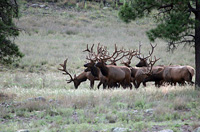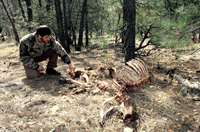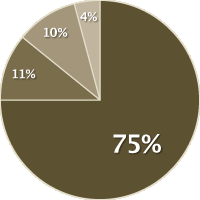Mexican Gray Wolf Habitat
Mexican wolves have been released into some of the mountainous forests and woodlands within their known historic range. They eat large and small mammals, and depend on a healthy population of large ungulates (elk, deer) to survive. They obtain most of their liquids through their food.

Photo Courtesy of the U.S. Fish and Wildlife Service
Several paved roads cross the Blue Range Wolf Recovery Area. Some established wolf home ranges include segments of paved roads; wolves use roadways as travel corridors and do not hesitate to cross roads. Roads may, however, impact the wolves’ reintroduction success due to collisions and increased interactions with humans.

Photo Courtesy of the U.S. Fish and Wildlife Service
Pack hunting revolves around the chase, as wolves are able to run for long periods before relenting. It takes careful cooperation for a pack to take down large prey, and the rate of success is low. As a result, Mexican wolves usually feed only a couple times a week, eating up to 20 pounds of meat at a time.

A biologist, above, looks at a cow elk killed by wolves. People hunt the same game that wolves prey upon.
Photo Courtesy of George Andrejko, Arizona Game and Fish Department
While wolves can impact prey populations, it’s usually because there are other factors involved that also stress the prey - deep snow, drought, or disease. Wolf-predator studies show that most wolves rarely eliminate their prey, but may influence the size of prey populations. For instance, a prey population that was increasing without wolves would still increase with the presence of wolves, but more slowly. Also, if the prey population was already declining, the presence of wolves could accelerate the decline.
Mexican Wolf Diet

Estimated diet of wolves in the Blue Range Wolf Recovery Area based on diet analysis. Intensive monitoring shows that elk are the most common prey.
- Elk: 75%
- Small Mammals/Unknown: 11%
- Deer: 10%
- Livestock: 4%